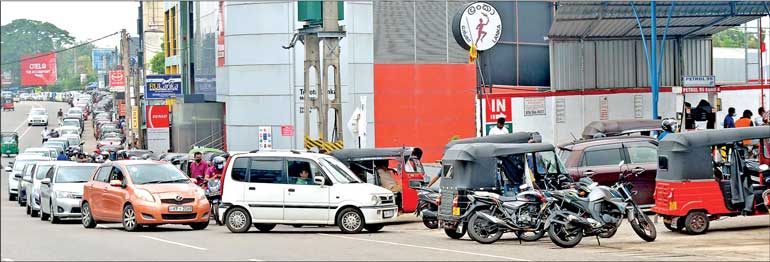Saturday Nov 15, 2025
Saturday Nov 15, 2025
Wednesday, 1 June 2022 00:20 - - {{hitsCtrl.values.hits}}

Hours spent in queues for fuel translate into production losses across the economy and in the quality of life
Queues are a problem faced by Sri Lankans every day now. There are few dollars. Therefore, essentials such as fuel for electricity production and transport are in short supply. Prices have gone up, but demand is still robust.
but demand is still robust.
With regard to electricity, the cost increases have not been passed down, yet. There is a degree of rationing, irrespective of willingness to pay or intensity of need. All are subjected to load shedding with rare exceptions.
In the case of fuel for transportation, the prices have gone up severalfold, but demand has not proportionately declined. Shortages have resulted in massive queues across the country. Costs of obtaining fuel have gone up in rupees and in time. Hours spent in queues for fuel translate into production losses across the economy and in the quality of life. The focus of this article is the allocation of fuel for transportation subject to the hard constraint of limited dollars.
There’s an app for that
For any problem, the first solution that comes to the minds of some is an app. If fed with the right inputs, an app can reduce information imperfections in the market. If reliable information about supply in specific locations (e.g., is the fuel station open? How much fuel in what varieties is available?) as well as the nature of demand in those locations (e.g., how long are the lines for diesel, petrol, etc.?) can be provided, aggravation and wasting of time can be reduced.
Such information, if accurate and if delivered promptly, can help match supply and demand more efficiently. When made aware of short queues at specific locations, vehicle owners may choose to incur additional costs in time and fuel to purchase from them, thus helping match overall demand more closely to overall supply.
However, when overall supply is constrained, information by itself cannot satisfy demand. The serendipitous discovery of a fuel station with a short, or no, queue will no longer be possible. All fuel stations will have more or less similar queues. This appears to be happening in Colombo because of Facebook groups and such.
If the app is available only to a subset of those wishing to obtain fuel, it can yield significant benefits to those persons. As a corollary, those who do not have the app will be disadvantaged. Therefore, this is a private solution that may earn the app developer some money and possibly the anger of non-users when they learn of it.
No harm will be caused by non-exclusionary apps that provide information on supply and demand by location. However, until the supply constraint is lifted, they will provide only incomplete relief.
Let the market rip
When demand outstrips supply, prices will go up. This will cause demand to decline in most instances, aligning demand to supply and eliminating shortages.
So far, even the rather substantial price increases based on Cabinet approvals and formulae have not reduced demand to match supply. Queues may be eliminated by high enough price increases. Here, the government would step back entirely from price regulation, as it did on several occasions with other commodities, and permit the duopolists (Ceypetco and LIOC) or even the owners of the individual fuel stations to set their own prices.
This will most likely eliminate the queues, but may result in widespread protests, including destruction of fuel stations and stocks. It is, therefore, advisable to exclude this option from consideration.
As can be seen from the reactions to the rapid sequence of price revisions, increases that are justified on the basis of the depreciation of the rupee or of increased world-market prices will be accepted. Especially in the context of a duopoly, price increases that are seen to be extortionary pose significant risks to public order.
Ration it
Rationing is the natural answer where the default thinking, especially among the age group with their hands on the levers of power, is derived from state socialism. Underlying this are assumptions that state officials are the best arbiters of consumption behaviours and that the costs of administering rationing schemes are negligible/worthwhile.
In the ideal case, state officials will correctly identify all deserving consumers and provide them with ration cards or coupons for their various needs. Ration books were introduced during the World War and continued until the early 1980s. All households were provided with ration books which entitled the owners to obtain goods from a government ration shop known as a “cooperative store” upon payment of specified prices. Different kinds of perforated coupons were provided. Being a universal scheme, the problem of accurate targeting was bypassed.
Ration books were among one’s most valuable possessions. One had to go in person to a government office to obtain a stamp on the passport that the ration book had been surrendered to obtain an exit permit to leave the country even for a few days.
Those deserving of special treatment could be identified and provided with different entitlements. Special treats such as tinned fish would be sold upon production of a ration book at festival times or before elections.
I have no recollection of fuel coupons, because mine was not a car-owning family. I am told there were printed and numbered coupons even for that.
The costs of implementing such rationing schemes were considerable. The possibilities of abuse were many and were well exploited. Newspapers of the time regularly featured stories about various kinds of ration-card frauds.
It will be argued that much simpler fuel rationing systems can be implemented now because of the ubiquity of ICT; and that the relatively small number of distribution outlets (850 served by Ceypetco and 202 by LIOC) and limited product range would make rationing feasible. Some have even proposed decentralised rationing schemes. One would be registered at a specific fuel station and could obtain supplies only from it. This appears to disregard the fact that vehicles are inherently mobile and does not address the refuelling needs of long-distance travellers.
The preconditions for an ICT-based rationing system for vehicles are a central database of the over five million vehicles that are on the roads and the capability of the approximately 1,000 fuel stations to query the database in realtime.
The first condition is partially satisfied because the Department of Motor Traffic (DMT) offers an online service whereby information on registered vehicles may be obtained. The second condition is challenging. While the fuel stations are being connected, it would be possible to upgrade the central database so it can reliably respond to the very high number of queries likely to be received at peak times.
It must be noted that this solution does not require any capabilities in the vehicles. The fuel station simply queries the database on the remaining allocation for the vehicle at the pump and dispenses fuel to that limit. This simple scheme does leave room for malfeasance at the level of the employees of the fuel station who may enter vehicle numbers fraudulently, etc.
Unless we are expecting permanent fuel supply constraints, it may not be worthwhile to implement a variation of the above-described scheme, tweaked to minimise opportunities for abuse. In any case, such a scheme will take time, and cannot solve our immediate problems.
Prioritise
A simpler rationing solution is to prioritise by vehicle type: ambulances, buses and trucks are prioritised over SUVs, vans, etc. for diesel; three-wheelers (which are mostly used for public transportation) are prioritised over cars and other vehicles for petrol. No databases are required because enforcement of the rules is crowdsourced to those with priority and bystanders. It is only when all prioritised demand is satisfied that others may refuel.
While recognising the efficiency of motorcycles in terms of road use and the fact that a subset is used for delivery services (a public function), it is difficult to prioritise them because most motorcycles are used for private transportation and their inclusion would make the priority scheme difficult to enforce. Only unambiguously identifiable categories must be prioritised.
The government may choose to cease importation of Super Diesel and high-grade petrol for the duration of the crisis, or to encourage the suppliers to establish separate outlets where prices are set at prohibitive levels to discourage use. The first option is the most logical until the dollar constraint is overcome.
The downside risks are considerable. Various interest groups will lobby hard to get the government to complicate the priority scheme and destroy its legitimacy and enforceability. For example, we may expect the GMOA to go on strike if doctors’ vehicles are not included (and for the stickers that are used to signify doctor’s vehicles to be pasted also on the vehicles of friends and relatives, if the vaccination prioritisation experience is any guide).
Providing fuel for generators that keep food and medicines safe during load shedding or for agricultural equipment will be a problem. Special provisions will have to be made for these and similar cases, which will harm the simplicity of the scheme and open the door to corruption, which tends to accompany all rationing schemes.
There will be incentives for those with priority to engage in arbitrage because those with no access to diesel or petrol will have incentive to pay a premium to purchase fuel from the tanks of those with fuel. One may expect a secondary market to emerge with time and flourish.
In sum, none of the options described above can provide sustainable, long-term solutions to the problem of eliminating queues. The “prioritise” solution, if kept simple, may work for a short time before the secondary market gets established. The fact that 137 persons had been arrested for illegal sale of petrol and diesel by 26 May, and that 27,000 litres of petrol and 22,000 litres of diesel had been confiscated, indicates that the secondary market has already been established.
The only long-term solution is removal of the supply constraint, competition where possible in the various market segments, and formula-based price setting in the interim. The short answer to the question of how to eliminate queues now is: establish a stable, all-party government and obtain bridge financing; address the twin deficits. Everything else is band-aid.